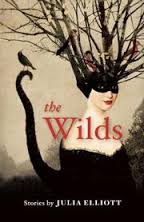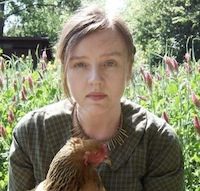
A trendy store in Portland sells oddities. Its taxidermy includes baby ducklings and fetal pigs. Owl pellets expose previously digested prey, and bleached animal skulls hang white and lonely on the walls. Articulated skeletons sit frozen under bell jars. It’s a glimpse of nature that’s exciting and a little gross, and yet I wanted to take all of it home, to remember the way I felt walking among this store’s strange inventory.
The stories in Julia Elliott’s debut collection The Wilds are like objects in a curiosities shop: grotesque, elegant, and fascinating. In “Regeneration at Mukti” a spa patient sheds scabby skin after weeks of blistering in hopes of emerging with a youthful complexion. In “Organisms” a strange bacteria renders teenagers addicted to social media and video games comatose, and in “Caveman Diet” attendees at a paleo conference wear caveman costumes. “Feral” follows a pack of wild dogs terrorizing a town, and in “The Wilds” a girl lovingly strokes the acne beneath her teenage neighbor’s wolf-mask. A crown of bird skulls, voodoo dolls, a feast of robins—Elliott’s curios are a breed all their own.
The book’s opening story sets the tone for a cohesive collection. In “The Whipping,” a girl awaits punishment for stealing cigarettes while her brothers shoot at birds in the backyard. The narrator has common coming-of-age concerns: “my bathing suit is hideous, my boobs are deformed, my freckles have darkened into an ugly swarm,” but Elliott hints at something more. A cat skull dangles from a shoelace tied round the narrator’s brother’s neck. This is part of the darkness that permeates Elliott’s writing and contributes gothic texture to her stories: “The underbellies of sluggish clouds glow a sickly green. My boxing brothers, who are now trying to kill each other, look like poisonous elves. All around them, half-naked boys with bent spines hoot and leer.”
“The Whipping” is one of Elliott’s more subtle pieces. Later we read about “tortured” lilies and womanhood that is “bound up with disease.” A character has “a beautiful dream in which I’m rolling in a patch of briars.” A duck raised on genetically modified corn has “Bleeding cankers of the flipper, cloacal tumors, swollen feather follicles.” Elliott’s word choice is macabre, and it pushes stories that are anchored by a sense of the everyday—family drama, sleepovers, paleo diets, teaching the seventh grade—into the surreal.

Most of Elliott’s stories focus on conflicts surrounding the rules of nature and humanity’s attempt to adapt to it or control it. “LIMBs” and “Jaws” reflect a fear of mortality—both have characters suffering from dementia. “Regeneration at Mukti” and “Caveman Diet” are driven by the fear of growing old and serve as cautionary tales against our culture’s preoccupation with youth and appearance. “Organisms” mixes commentary on our technology-obsessed culture with a vulnerability to disease. In “Feral,” a teacher un-domesticates. She begins to smell the pack dogs terrorizing her town and is lured into their wild fray: “Our own town fit the usual profile: failing schools, rinky-dink chicken farms, and closing plants, an obese and debt-strapped populace… their offspring suffering new configurations of hyperactivity disorders and social dysfunction.” This passage reflects a recurring theme of disappointment in the status quo—in this instance, our socioeconomic norms are so flawed and unsatisfying that a de-evolution into nature is the best (and only) option.
This sense of rebelling continues. In the book’s final story, “The End of the World,” a band tries to regroup for one final song. One member lives in a cabin where he eats only what he can kill or forage. Except something is amiss. “Bill himself looks a bit green under the gills—way too skinny… so skinny that his pants hang from his pelvic bones, his eye sockets look deeper, and his neck resembles a delicate stalk.” In this piece Elliott makes sly reference to the other stories in her collection, as if to indicate that “The End of the World” depicts a time and place that has accumulated all of The Wilds’ strange events. In Elliott’s final story there is no correct way to live; her characters are trapped by forces outside their control in spite of their efforts to escape. She is perhaps telling us that at the end of it all, our best efforts may not be enough.
You may think you’ve read this book or something like it. Female short story writers like Kelly Link, Karen Russell, Aimee Bender, and Amelia Gray have made names for themselves by writing absurd and surreal tales. What I like so much about Elliott’s work is that her writing reflects dissatisfaction with where we are going as a society. Her characters are being propelled toward an end that is inevitable and unsatisfying. Elliott writes about big issues: how we treat our senior citizens, the spread of viruses, the fear of growing old, the excess of vanity, the hypocrisy of religion, the quality of our food, the precariousness of technology, and yes, the end of the world. Pirates invade, characters worry about the death toll in Afghanistan, and people sunburn. A grandmother levitates above the couch, a mechanical shark terrifies an aging woman, and a robot feels love. Elliott is a prose stylist and thinker all her own. Her work is unique and haunting, often drifting into apocalyptic and dystopian territory, but in many ways rooted in reality. I could not turn away from her tales. At the end of my time with The Wilds, I was completely devoted to Elliott’s dark depictions of the world.




